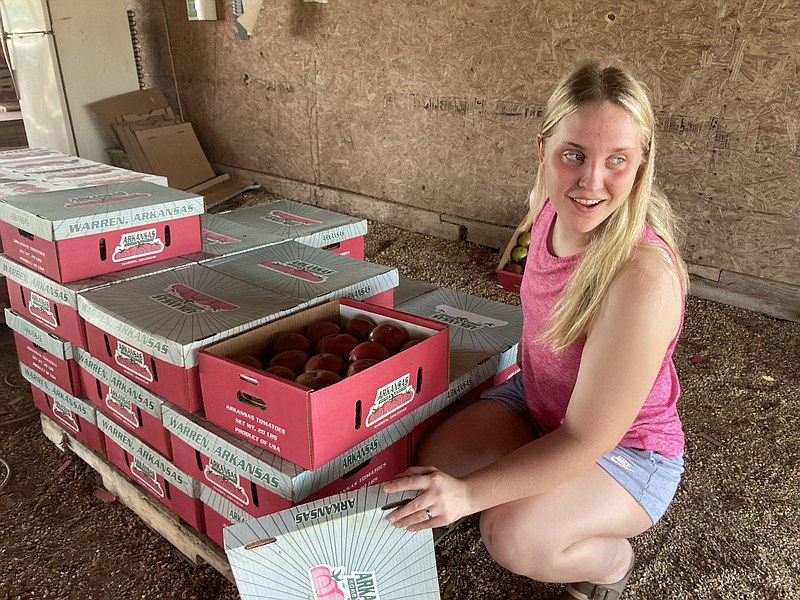At the sound of the approaching four-wheeler, Lady Bug got a jump in her step, darting under a customer's pickup truck.
Sixteen-year-old Kailey Henry rolled up to the shed, turned off the machine and dismounted, allowing the hiding black-and-white cat, one of several farm critters, to return to her nonchalant saunter around her domain.
Henry, a senior at Warren High School, was about to get busy on her family's tomato farm, sorting fruit, making boxes and lids and loading them up with the numerous varieties they grow: Bradleys, pink girls, yellows and Cherokee purples, which is a popular heirloom variety, to name a few.
It was just mid-morning, but Henry's mom, Sheri Henry, already looked tired. The weather has been one concern for her, providing a daily dose of upper-90-degree heat, which she described as "horrible" and more reminiscent of mid-July than mid-June, and the fact that she can't find workers to pick her crop.
"Used to, you could drive into town and get a truckload of guys," she said, referring to nearby Warren. "You can't do that now. Now one wants to work."
One option for workers would be the federal H-2A program through which laborers can be brought in on a temporary basis to help with agricultural work.
But Sheri Henry said the program isn't geared toward farms her size.
"You have to pay to get them here from Mexico, for instance," she said, "and then put them up in nice accommodations and pay them and then pay their way back home. And I get the need for that, but by the time you pay all of that, for the small farmer, it's not feasible. There goes your whole crop."
The Henry's farm is located near Banks off of Highway 278. Sheri Henry farms about 14 acres but only eight of that are in tomatoes. The rest is taken up with other produce such as peppers, squash and melons.
Asked what her options are in light of the labor shortage, she paused.
"We'll do the best we can with what we have to work with," she said.
Smaller tomato farms, like the Henry's, dot the Bradley County landscape as well as that of Ashley and Drew counties, according to John Gavin, the Bradley County extension agent for agriculture for the University of Arkansas. As for the heat and lack of workers – Gavin was singing out of the same hymnal as Sheri Henry on the topics.
"I'm going to have to agree with her," he said by phone. "It's harder to find local labor. You're having to pay more for common laborers these days, if you can find local labor at all. They're more and more difficult to find. That is a bottleneck in the system, especially at harvest. That's a hard job."
As for the federal worker program, Gavin said the wages for those individuals was set purposely high – higher than minimum wage – so as not to compete with the local labor supply.
"It's hard for one farmer to navigate that system," he said. "It's got to all be prearranged." It's really for the larger operation."
And the weather? Gavin said the incessant heat, which seems to be breaking a bit this week, has been the biggest problem for tomato farmers
"It's just hammering the vines," he said. "It's just been consistently hot. And it's taking its toll. Each plant is a little pumping station, bringing moisture up from the ground to the fruit, and they're all on overtime trying to keep up."
On the plus side, he said, most farmers are doing what they need to do to stay ahead of the heat, meaning they are irrigating more so that plants are able to fill out the fruit as it ripens. Disease and insects also seem to be under control, he said.
In Bradley County, Gavin said, there are some 350 to 400 acres of tomatoes being grown this year, a number that has been fairly stable. In Ashley and Drew counties, another 250 to 300 acres are used for tomato growing.
"We've got Romas, cherries, grapes, heirlooms and commercial," he said. "And that's not counting the gardens."
Gavin said that overall, the crop was looking good and that the trend for farmers to grow fewer acres of tomatoes and more acres of other produce continues as it gives customers something else to buy while visiting area farms.
"It used to be all tomatoes," he said. "But growing 15 acres of tomatoes is not profitable or fun."
